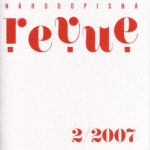Journal of Ethnography 2/2007 pays its attention to handicrafts. In his essay, Josef Jančář summarizes the interest in folk handicrafts in the European context from the 19th century up to the present (Development of Handicraft Care). Oľga Danglová elucidates the development of the Centre for Folk Art Production in Bratislava (Between traditions and modern design. Activities of the Slovak Centre for Folk Art Production). Jarmila Pechová devotes herself to the particular kinds of handicrafts in Central Moravia in the second half of the 20th century (On the past and present of handicrafts and homemade manufactures in Central Moravia). Pipe manufacture, its history and local traditions are the theme of Luboš Kafka ́s essay (Tradition and Present of Pipe Manufacture in Proseč near Skuteč). Václav Michalička elucidates the manual technique for whetstone manufacture (The Sucháček Family – four generations of handmade-whetstones manufacturers in the region of Walachia).
„Fotografická zastavení“ (Stopping with Photos) section and Transferring Tradition column bring the contributions by Daniel Drápala (Basket-Making Classes and Workshop in Rožnov pod Radhoštěm) and by Věra Kovářů (Wind Mill in Starý Poddvorov). Social Chronicle remembers the anniversaries of the ethnologist Zdena Vachová (born 1922) and musician Vladimír Baier (born 1932); it publishes also the obituary notice for the architect and photographer Jaroslav Vajdiš (1920 – 2006). In other regular columns, the reports of conferences, festivals, concerts and reviews of new book editions have been published.
Development of Handicraft Care
Since the 19th century, the development of scientific researches and their practical application formed a qualitatively higher stage of civilization in which the traditional artisanship ceased to exist. The states tried to avoid that process by their legislative measures, as it was in Austro-Hungary, where the trade law was issued in 1859 or the cooperative system law in 1873. Various training courses were organized and producers ́ and sale cooperatives came into being to build the handicrafts up into going process. After the World War II, an international organization with the name European Federation of Folk Art was established in Europe. In Czechoslovakia, the Centre for Folk Art Production was founded, which was dissolved after one year of its existence. Nowadays, the Czech Republic has joined the UNESCO appeal to support the declining handicrafts by awarding the best artisans the title Folk Craft Tradition Practitioner.
Between traditions and modern design. Activities of the Slovak Centre for Folk Art Production
The essay submits an overview of the present activities of the Centre for Folk Art Production in Bratislava. The main scope of work of this institution is to register the co-operation with the manufacturers, to look for new talents and to support their manufacture under professional supervision, to renew and extend the assortment of products by means of artists ́ designs and to organize the purchase of products within the sales network of this institution. The bigger stress is put on educational activity. Besides training courses and lectures for the manufacturers, the scope of education is open even for the wider public by means of the Court of Crafts (a 1999 founded centre for information and education). The range of promotion activities by editorial works and exhibition activities is more intensive as well. The institution issues its own journal Remeslo/Umenie/Dizajn (Craft/Art/Design) and four times a year, it organizes exhibitions at its own gallery opened in 2004. Major attention is paid to collection funds care, archives completion, photo-documentation and video-documentation and – as the newest activity – virtual gallery creation.
On the past and present of handicrafts and homemade manufactures in Central Moravia
While in the lowland part of Central Moravia mainly the handicrafts important for agriculture were carried on up to the 20th century, the range of handicrafts and homemade manufactures was much more varied in the higher situated regions. The expiring of traditional manufactures since the 1940s or their recapture by the Centre for Folk Art Production can be followed based on safeguarded sources processed for official and statistical needs. The present manufacture continues the family and regional traditions (basket-making in the region of Morkovicko, products made of straw in the region of Konicko); partially, it is developing in other directions connected with personal concerns, possibilities and abilities of their bearers.
Tradition and Present of Pipe Manufacture in Proseč near Skuteč
The village of Proseč near Skuteč at Czech-Moravian Highlands was one of the most famous Bohemian centres of pipe manufacture for wide range of purchasers since the first half of the 19th century. The pipes cut and turned of domestic, simply available timber sorts (alder) as well as those made of imported briar since the beginning of the 20th century were made here. The peak of the local pipe manufacture falls within the period of the first Czechoslovak republic when hundreds of local people carried on pipe manufacture, belt making and additional home production. After the World War II, the workshops, private plants and factories were dissolved. The manufacture was concentrated into one big cooperative with machinery mass production. With exceptions (pipe-manufacturer J. Klinský), the traditional handmade manufacture of minor cutters and pipe manufacturers terminated. Nowadays, the works by F. Loučka and V. Jehlička present its modified repercussions.
The Sucháček Family – four generations of handmade-whetstones manufacturers in the region of Walachia
The manufacture of whetstones belongs to simple archaic techniques. The manufacture was typical especially for the villages around the town of Vsetín in the past. Since the 1920s, the men of the Sucháček family have managed the techniques of manual whetstone manufacture. Because of the transformation of society and its needs within the second half of the 20th century, the Sucháčeks have become the only practitioners of that technique in the region that dominated the whetstone manufacture before. The technique applied by them did not undergo any significant changes; however, the social and economical conditions changed. The originally homemade manufacture has changed into educational-entertaining gainful employment with cultural legacy of the past.



